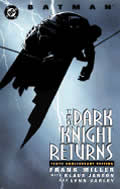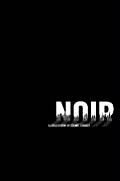The Significance of a Pearl Necklace
Frank Miller introduced several icons of the Batman mythos in The Dark Knight Returns, including the Jason Todd trophy case and the phrase “boy hostage.”
Perhaps the most powerful of his visual innovations is the pearl necklace that Martha Wayne wears when she is murdered. The breaking of that necklace, its white pearls spilling loose on the sidewalk, symbolizes how young Bruce’s family was destroyed. It evokes the loss of his parents’ death without showing the violence. If I wanted to get artistic, I could talk about the round, white pearls contrasting with spiky, black batarangs.
The necklace has reappeared in nearly every retelling of and flashback to that event since, including the animated television series and the movie Batman Begins. Often comics creators can simply show a panel of round white pearls falling, knowing their readers (who generally know the mythos already) will read that image to stand for all of Bruce Wayne’s traumatized childhood.
A good demonstration of that iconographic power appears in Noir, an anthology of crime comics published in 2009. The last tale, “The Bad Night” by Brian Azzarello, Fábio Moon, and Gabriel Bá, involves a down-on-his-luck man agreeing to pretend to mug a family and steal a necklace so the owner can collect the insurance.
“Nothin’ to worry about,” the narrator says in the last panel—but that panel closes in on the woman’s pearl necklace. And superhero comics readers see that everything can go wrong, and probably will. In fact, the ending makes no sense at all without the symbolic significance that Frank Miller had invested in those pearls two decades before.
That’s all the more striking since Noir wasn’t published by DC Comics, which owns the copyright on Martha Wayne’s pearl necklace, but by Dark Horse. Azzarello has written stories for DC, including the alternative-Batman stories for the “Flashpoint” crossover, which also started with the Waynes’ mugging, but in this case he was building off of that company’s world elsewhere.
Perhaps the most powerful of his visual innovations is the pearl necklace that Martha Wayne wears when she is murdered. The breaking of that necklace, its white pearls spilling loose on the sidewalk, symbolizes how young Bruce’s family was destroyed. It evokes the loss of his parents’ death without showing the violence. If I wanted to get artistic, I could talk about the round, white pearls contrasting with spiky, black batarangs.
The necklace has reappeared in nearly every retelling of and flashback to that event since, including the animated television series and the movie Batman Begins. Often comics creators can simply show a panel of round white pearls falling, knowing their readers (who generally know the mythos already) will read that image to stand for all of Bruce Wayne’s traumatized childhood.
A good demonstration of that iconographic power appears in Noir, an anthology of crime comics published in 2009. The last tale, “The Bad Night” by Brian Azzarello, Fábio Moon, and Gabriel Bá, involves a down-on-his-luck man agreeing to pretend to mug a family and steal a necklace so the owner can collect the insurance.
“Nothin’ to worry about,” the narrator says in the last panel—but that panel closes in on the woman’s pearl necklace. And superhero comics readers see that everything can go wrong, and probably will. In fact, the ending makes no sense at all without the symbolic significance that Frank Miller had invested in those pearls two decades before.
That’s all the more striking since Noir wasn’t published by DC Comics, which owns the copyright on Martha Wayne’s pearl necklace, but by Dark Horse. Azzarello has written stories for DC, including the alternative-Batman stories for the “Flashpoint” crossover, which also started with the Waynes’ mugging, but in this case he was building off of that company’s world elsewhere.




No comments:
Post a Comment